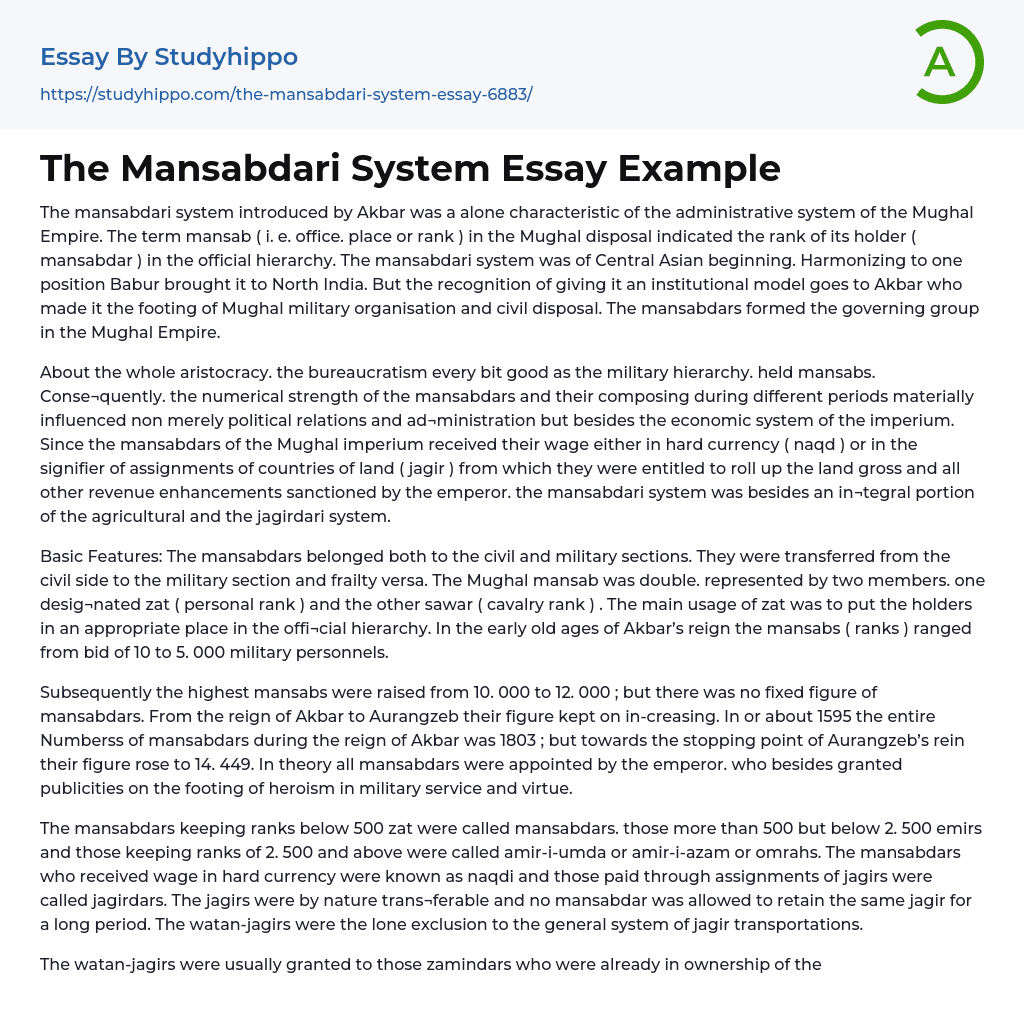The mansabdari system introduced by Akbar was a alone characteristic of the administrative system of the Mughal Empire. The term mansab ( i. e. office. place or rank ) in the Mughal disposal indicated the rank of its holder ( mansabdar ) in the official hierarchy. The mansabdari system was of Central Asian beginning. Harmonizing to one position Babur brought it to North India. But the recognition of giving it an institutional model goes to Akbar who made it the footing of Mughal military organisation and civil disposal. The mansabdars formed the governing group in the Mughal Empire.
About the whole aristocracy. the bureaucratism every bit good as the military hierarchy. held mansabs. Conse¬quently. the numerical strength of the mansabdars and their composing during different periods materially influenced non merely political relations
...and ad¬ministration but besides the economic system of the imperium. Since the mansabdars of the Mughal imperium received their wage either in hard currency ( naqd ) or in the signifier of assignments of countries of land ( jagir ) from which they were entitled to roll up the land gross and all other revenue enhancements sanctioned by the emperor. the mansabdari system was besides an in¬tegral portion of the agricultural and the jagirdari system.
Basic Features: The mansabdars belonged both to the civil and military sections. They were transferred from the civil side to the military section and frailty versa. The Mughal mansab was double. represented by two members. one desig¬nated zat ( personal rank ) and the other sawar ( cavalry rank ) . The main usage of zat was to put the holders in an appropriate place in the offi¬cial hierarchy. I
the early old ages of Akbar’s reign the mansabs ( ranks ) ranged from bid of 10 to 5. 000 military personnels.
Subsequently the highest mansabs were raised from 10. 000 to 12. 000 ; but there was no fixed figure of mansabdars. From the reign of Akbar to Aurangzeb their figure kept on in-creasing. In or about 1595 the entire Numberss of mansabdars during the reign of Akbar was 1803 ; but towards the stopping point of Aurangzeb’s rein their figure rose to 14. 449. In theory all mansabdars were appointed by the emperor. who besides granted publicities on the footing of heroism in military service and virtue.
The mansabdars keeping ranks below 500 zat were called mansabdars. those more than 500 but below 2. 500 emirs and those keeping ranks of 2. 500 and above were called amir-i-umda or amir-i-azam or omrahs. The mansabdars who received wage in hard currency were known as naqdi and those paid through assignments of jagirs were called jagirdars. The jagirs were by nature trans¬ferable and no mansabdar was allowed to retain the same jagir for a long period. The watan-jagirs were the lone exclusion to the general system of jagir transportations.
The watan-jagirs were usually granted to those zamindars who were already in ownership of their watans ( fatherlands ) before the enlargement of the Mughal imperium. The mansab was non familial and it automatically lapsed after the decease or dismissal of the mansabdar. The boy of a mansabdar. if he was granted a mansab. had to get down anew. Another of import characteristic of the mansabdari system was the jurisprudence of escheat ( zabti ) . harmonizing to which
when a mansabdar died all his belongings was confiscated by the emperor. This step had been introduced so that the mansab¬dars did non work the people in a cavalier mode.
- Non-Commissioned Officer essays
- Sergeant essays
- Business Law essays
- Contract essays
- Consumer Protection essays
- Property essays
- Ownership essays
- Agreement essays
- Common Law essays
- Contract Law essays
- Justice essays
- Security essays
- Tort Law essays
- United States Constitution essays
- Crime essays
- Lawsuit essays
- Treaty essays
- Family Law essays
- Marijuana Legalization essays
- Constitution essays
- War on Drugs essays
- Court essays
- Jury essays
- Police essays
- Protection essays
- Community Policing essays
- Criminal Law essays
- Judge essays
- Lawyer essays
- Employment Law essays
- Copyright Infringement essays
- Injustice essays
- Intellectual Property essays
- Breach Of Contract essays
- Jurisprudence essays
- Social Injustice essays
- Juvenile Justice essays
- Internet Privacy essays
- Cyber Security essays
- Bill Of Rights essays
- Civil Liberties essays
- First Amendment To The United States Constitution essays
- Fourth Amendment To The United States Constitution essays
- Second amendment essays
- Animal Cruelty essays
- Law Enforcement essays
- Juvenile Justice System essays
- Surveillance essays
- Forensic Science essays
- Crime Prevention essays




